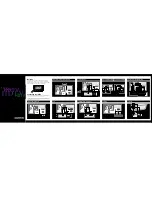
VIZIO VA26L HDTV10T User Manual
Version 6/5/2008
14
www.VIZIO.com
Setting Up Your HDTV
•
Read this user manual carefully before installing your HDTV.
•
The power consumption of your HDTV is about 105W. Use the included power cord. When an
extension cord is required, use one with the correct power rating. The cord must be grounded and
the grounding feature must not be compromised.
•
Your HDTV should be installed on a flat surface to avoid tipping.
•
For proper ventilation, you must allow space between the back of your HDTV and the wall.
•
If you want to mount your HDTV on the wall, see “ Wall Mounting your HDTV” for additional
information.
•
Avoid installing your HDTV in places with high humidity, dust, or smoke so you do not shorten the
service life of the electronic components.
•
Install your HDTV in a level, landscape orientation, with the VIZIO logo at the bottom to prevent
poor ventilation and excessive component damage.
VIZIO offers professional installation services. Contact VIZIO for more information on these services at
888-VIZIOCE (888-849-4623) or www.VIZIO.com.
Choosing a video connection
Your HDTV has six different ways to connect your video equipment from a basic connection to the most
advanced for digital displays.
Connection
Quality (type)
Connector
Rear & Side Panel
Color Code
Description
Best
(digital)
White (Rear)
HDMI (High-Definition Multimedia Interface).
HDMI is the
first and only industry-supported, uncompressed, all-digital
audio/video interface. HDMI connects an AV device (such
as a set-top box, DVD player, or A/V receiver) to your HDTV
using one cable to carry both the audio and video.
Best
(digital)
- - - - - - - - -
Good
(analog)
Black (Rear)
DTV Coaxial RF.
For digital programming, this input takes
advantage of high-definition content.
- - - - - - - - - - - - - - - - - - - - - - - - - - - - - -
TV Coaxial RF.
The connection for standard NTSC TV
using antenna or cable.
Best
(analog)
Blue (Rear)
RGB PC (VGA).
This is most commonly used connecting a
computer.
Better
(analog)
Green (Rear)
Component.
The video signal is separated into three
signals, one containing the black-and-white information and
the other two containing the color information. This
enhancement over S-Video takes advantage of the superior
picture provided by progressive scan DVD players and
HDTV formats.
Good
(analog)
Orange (Side)
S-Video.
The video signal is separated into two signals, one
containing the black-and-white information and the other
containing the color information. Separating the color in this
way avoids ‘cross color’ effects where closely spaced black
and white lines are erroneously displayed in color. It also
enables text to be displayed more sharply.
Good
(analog)
Yellow (Rear)
Orange (Side)
Composite.
The video signal is carried through the yellow
jack and the audio is carried through the white and red
jacks. This is the most commonly used video connection.
NOTE:
For more information refer to the Quick Start Guide.














































